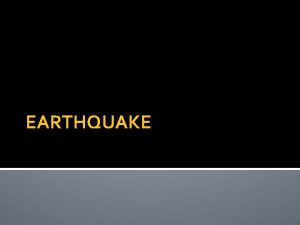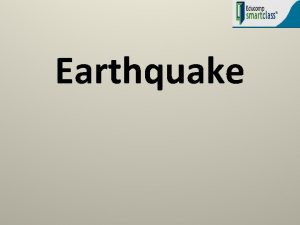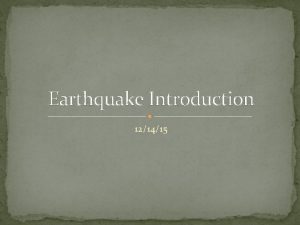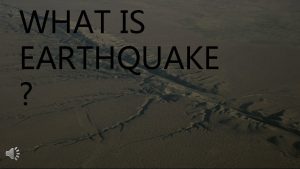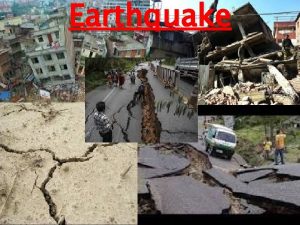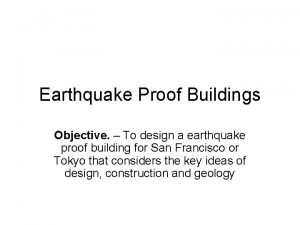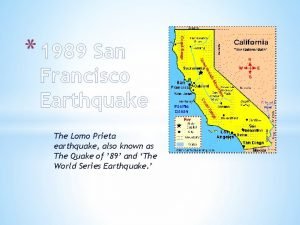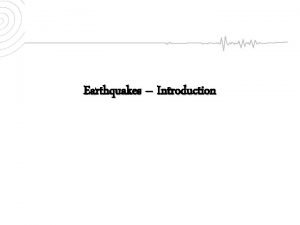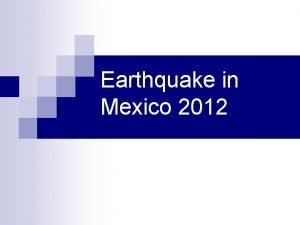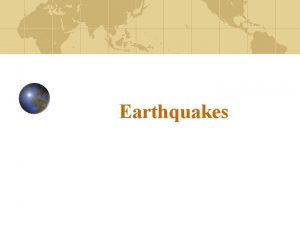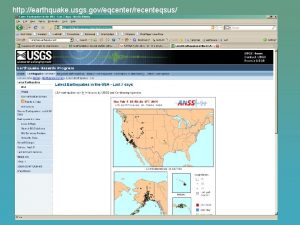What is an Earthquake An Earthquake is the
















- Slides: 16

What is an Earthquake? • An Earthquake is the vibrations produced when a rock snaps and breaks under different types of stress.

Types of Stress • Tensional – pulls rocks APART https: //www. as. uky. edu/ sites/default/files/elearn ing/module 10 swf. swf • Compressional – pushes rocks TOGETHER • Shearing – pulls rocks ALONG each other

The Elastic Rebound Theory • Rocks will bend until they reach their Elastic Limit. • Then they will break (crack) – This forms a Fault

How do Earthquakes Occur? • Rocks on a fault are jagged & get stuck when plates move. • Stress Builds • Rocks bend until they can’t & then snap back to their original position. (Elastic Rebound Theory)

Parts of a Fault Footwall Hanging Wall

Types of Faults http: //www. classzone. com/books/earth_science/terc/content/visualizations/ es 1103/es 1103 page 01. cfm

Normal Fault

Caused by Tensional Stress • • • Rocks/plates are pulled apart Tension causes the hanging wall to fall down. Divergent Boundary

Reverse Fault

Caused by Compressional Stress • • Rocks/plates are pushed together. Causes the Hanging wall to move up. Earthquakes!!!! Convergent Boundary

Thrust Fault • A special Reverse fault • Angle of fault plane is shallow.

Strike-Slip Fault

Caused by Shearing Stress • • Rock/plates are sliding in opposite directions. Movement is only horizontal. EARTHQUAKES!!! Transform Boundary

Oblique-Slip Fault • Horizontal and Vertical Movement • Caused by Tensional and Shear Stress


Type of folds activity • The foldable is due at the end of this class • Follow directions carefully • Neat drawings and hand writing please • Each student will work independently: Use your note and/ or the text book
 Sơ đồ cơ thể người
Sơ đồ cơ thể người Phản ứng thế ankan
Phản ứng thế ankan Tư thế ngồi viết
Tư thế ngồi viết Số.nguyên tố
Số.nguyên tố Các môn thể thao bắt đầu bằng tiếng nhảy
Các môn thể thao bắt đầu bằng tiếng nhảy đặc điểm cơ thể của người tối cổ
đặc điểm cơ thể của người tối cổ Hát kết hợp bộ gõ cơ thể
Hát kết hợp bộ gõ cơ thể Các châu lục và đại dương trên thế giới
Các châu lục và đại dương trên thế giới ưu thế lai là gì
ưu thế lai là gì Thẻ vin
Thẻ vin Trời xanh đây là của chúng ta thể thơ
Trời xanh đây là của chúng ta thể thơ Bàn tay mà dây bẩn
Bàn tay mà dây bẩn Voi kéo gỗ như thế nào
Voi kéo gỗ như thế nào Từ ngữ thể hiện lòng nhân hậu
Từ ngữ thể hiện lòng nhân hậu Tư thế ngồi viết
Tư thế ngồi viết Thế nào là hệ số cao nhất
Thế nào là hệ số cao nhất Giọng cùng tên là
Giọng cùng tên là

















